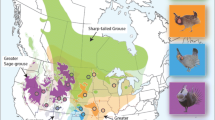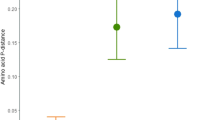Abstract
The red squirrel (Sciurus vulgaris) population in the United Kingdom has declined over the last century and is now on the UK endangered species list. This is the result of competition from the eastern grey squirrel (S. carolinensis) which was introduced in the 19th century. However, recent evidence suggests that the rate of population decline is enhanced by squirrelpox disease, caused by a viral infection carried asymptomatically by grey squirrels but to which red squirrels are highly susceptible. Population genetic diversity provides some resilience to rapidly evolving or exotic pathogens. There is currently no data on genetic diversity of extant UK squirrel populations with respect to genes involved in disease resistance. Diversity is highest at loci involved in the immune response including genes clustered within the major histocompatibility complex (MHC). Using the class II DRB locus as a marker for diversity across the MHC region we genotyped 110 red squirrels from locations in the UK and continental Europe. Twenty-four Scvu-DRB alleles at two functional loci; Scvu-DRB1 and Scvu-DRB2, were identified. High levels of diversity were identified at both loci in the continental populations. In contrast, no diversity was observed at the Scvu-DRB2 locus in the mainland UK population while a high level of homozygosity was observed at the Scvu-DRB1 locus. The red squirrel population in the UK appears to lack the extensive MHC diversity associated with continental populations, a feature which may have contributed to their rapid decline.




Similar content being viewed by others
References
Anisimova M, Gascuel O (2006) Approximate likelihood ratio test for branches: a fast, accurate and powerful alternative. Syst Biol 55:539–552
Babik W, Durka W, Radwan J (2005) Sequence diversity of the MHC DRB gene in the Eurasian beaver (Castor fiber). Mol Ecol 14:4249–4257
Barratt EM, Gurnell J, Malarky G, Deaville R, Bruford MW (1999) Genetic structure of fragmented populations of red squirrel (Sciurus vulgaris) in the UK. Mol Ecol 8:55–63
Barreiro LB, Quintana-Murci L (2010) From evolutionary genetics to human immunology: how selection shapes host defense genes. Nature Rev Genet 11:17–30
Bernatchez L, Landry C (2003) MHC studies in nonmodel vertebrates: what have we learned about natural selection in 15 years? J Evol Biol 16:363–377
Bertolino S, Lurz PWW, Sanderson R, Rushton SP (2008) Predicting the spread of the American grey squirrel (Sciurus carolinensis) in Europe: a call for a co-ordinated European approach. Biol Conserv 141:2564–2575
Bertolino S, Cordero di Montezemolo N, Wauters LA, Martinoli A (2014) A grey future for Europe: Sciurus carolinensis is replacing red squirrels in Italy. Biol Invasions 16:53–62
Biedrzycka A, Radwan J (2008) Population fragmentation and major histocompatibility complex variation in the spotted suslik, Spermophilus suslicus. Mol Ecol 17:4801–4811
Bjorkman PJ, Saper MA, Samraoui B, Bennett WS, Strominger JL, Wiley DC (1987) Structure of human class I histocompatibility antigen. Nature 329:506–512
Brown JH, Jardetzky TS, Gorga JC, Stern LJ, Urban RG, Strominger JL, Wiley DC (1993) Three-dimensional structure of the human class II histocompatibility antigen HLA-DR1. Nature 364:33–39
Charlesworth D, Willis JH (2009) The genetics of inbreeding depression. Nat Rev Genet 10:783–796
Cížková D, Gouy de Bellocq J, Baird SJ, Piálek J, Bryja J (2011) Genetic structure and contrasting selection pattern at two major histocompatibility complex genes in wild house mouse populations. Heredity 106:727–740
Darby AC, McInnes CJ, Kjær KH, Wood AR, Hughes M, Martensen PM, Radford AD, Hall N, Chantrey J (2014) Novel host-related virulence factors are encoded by squirrelpox virus, the main causative agent of epidemic disease in red squirrels in the UK. PLoS ONE 9:e96439
Ellegren H, Hartman G, Johansson M, Andersson L (1993) Major histocompatibility complex monomorphism and low-levels of DNA fingerprinting variability in a reintroduced and rapidly expanding population of beavers. Proc Natl Acad Sci USA 90:8150–8153
Everest DJ, Shuttleworth CM, Stidworthy MF, Grierson SS, Duff JP, Kenward RE (2014) Adenovirus: an emerging factor in red squirrel Sciurus vulgaris conservation. Mammal Rev 44:225–233
Frankham R, Ralls K (1998) Inbreeding leads to extinction. Nature 392:441–442
Germain RN, Margulies DH (1993) The biochemistry and cell biology of antigen processing and presentation. Annu Rev Immunol 11:403–450
Grill A, Amori G, Aloise G, Lisi I, Tosi G, Wauters LA, Randi E (2009) Molecular phylogeography of European Sciurus vulgaris: refuge within refugia? Mol Ecol 18:2687–2699
Gurnell J, Clark MJ, Lurz PWW, Shirley MDF, Rushton SP (2002) Conserving red squirrels (Sciurus vulgaris): mapping and forecasting habitat suitability using a geographic information systems approach. Biol Conserv 105:53–64
Gurnell J, Wauters LA, Lurz PW, Tosi G (2004) Alien species and interspecific competition: effects of introduced eastern grey squirrels on red squirrel population dynamics. J Anim Ecol 73:26–35
Hale ML, Lurz PWW, Shirley MDF, Rushton S, Fuller RM, Wolff K (2001) Impact of landscape management on the genetic structure of red squirrel populations. Science 293:2246–2248
Hale ML, Lurz PWW, Wolff K (2004) Patterns of genetic diversity in the red squirrel: footprints of biogeographic history and artificial introductions. Conserv Genet 5:167–179
Harris S, Morris P, Wray S (1995) A review of British mammals: population estimates and conservation status of British mammals other than cetaceans. Report to the Joint Nature Conservation Committee, Peterborough
Horton R, Wilming L, Rand V, Lovering RC, Bruford EA, Khodiyar VK, Lush MJ, Povey S, Talbot CC Jr, Wright MJ, Wain HM, Trowsdale J, Ziegler A, Beck S (2004) Gene map of the extended human MHC. Nature Rev Genet 5:889–899
Hughes AL, Nei M (1989) Nucleotide substitution at major histocompatibility complex class II loci: evidence for overdominant selection. Proc Natl Acad Sci USA 86:948–962
Hughes AL, Yeager M (1998) Natural selection at major histocompatibility complex loci of vertebrates. Annu Rev Genet 32:415–434
Jukes TH, Cantor CR (1969) Evolution of protein molecules. In: Munro HN (ed) Mammalian protein metabolism III. Academic Press, New York, pp 21–132
Keller L, Waller D (2002) Inbreeding effects in wild populations. Trends Ecol Evol 17:230–241
Kenward RE, Holm JL (1993) On the replacement of the red squirrel in Britain: a phytotoxic explanation. Proc R Soc B- Biolog Sci 251:187–194
Klein J, Bontrop RE, Dawkins RL, Erlich HA, Gyllensten UB, Heise ER, Jones PP, Parham P, Wakeland EK, Watkins DI (1990) Nomenclature for the major histocompatibility complexes of different species: a proposal. Immunogenetics 31:217–219
Kumanovics A, Takada T, Lindahl KF (2003) Genomic organization of the mammalian MHC. Annu Rev Immunol 21:629–657
La-Rose JP, Meredith AL, Everest DJ, Fiegna C, McInnes CJ, Shaw DJ, Milne EM (2010) Epidemiological and postmortem findings in 262 red squirrels (Sciurus vulgaris) in Scotland, 2005 to 2009. Vet Rec 167:297–302
Mainguy J, Worley K, Cote SD (2007) Low MHC DRB class II diversity in the mountain goat: past bottlenecks and possible role of pathogens and parasites. Conserv Genet 8:885–891
Martinoli A, Bertolino B, Preatoni DG, Balduzzi A, Marsan A, Genovesi P, Tosi G, Wauters LA (2010) Headcount 2010: the multiplication of the grey squirrel populations introduced in Italy. Hystrix Ital J Mammal 21:127–136
McInnes CJ, Wood AR, Thomas K, Sainsbury AW, Gurnell J, Dein FJ, Nettleton PF (2006) Genomic characterization of a novel poxvirus contributing to the decline of the red squirrel (Sciurus vulgaris) in the UK. J Gen Virol 87:2115–2125
Meredith A, Del Pozo J, Smith S, Milne E, Stevenson K, McLuckie J (2014) Leprosy in red squirrels in Scotland. Vet Rec 175:285–286
Meyer D, Thomson G (2001) How selection shapes variation on the human major histocompatibility complex: a review. Annals of Human Genet 65:1–26
Middleton AD (1930) Ecology of the American gray squirrel in the British Isles. Proc Zool Soc Lond 100:809–843
Mikko S, Andersson L (1995) Low major histocompatibility complex class-II diversity in European and North-American moose. Proc Natl Acad Sci USA 92:4259–4263
Milne I, Lindner D, Bayer M, Husmeier D, McGuire G, Marshall DF, Wright F (2008) TOPALi v2: a rich graphical interface for evolutionary analyses of multiple alignments on HPC clusters and multi-core desktops. Bioinformatics 25:126–127
O’Brien SJ, Roelke ME, Marker L, Newman A, Winkler CA, Meltzer D, Colly L, Evermann JF, Bush M, Wildt DE (1985) Genetic basis for species vulnerability in the cheetah. Science 227:1428–1434
Osborne AJ, Pearson J, Negro SS, Chilvers BL, Kennedy MA, Gemmell NJ (2015) Heterozygote advantage at MHC DRB may influence response to infectious disease epizootics. Mol Ecol 24:1419–1432
Radwan J, Biedrzyck A, Babik W (2010) Does reduced MHC diversity decrease viability of vertebrate populations? Biol Conserv 143:537–544
Reche PA, Reinherz EL (2003) Sequence variability analysis of human class I and class II MHC molecules: functional and structural correlates of amino acid polymorphisms. J Mol Biol 331:623–641
Ricanova S, Bryja J, Cosson J-F, Gedeon C, Choleva LS, Ambros M, Sedlacek F (2011) Depleted genetic variation of the European ground squirrel in Central Europe in both microsatellites and the major histocompatibility complex gene: implications for conservation. Conserv Genet 12:1115–1129
Robinson J, Halliwell JA, McWilliam H, Lopez R, Marsh SG (2013) IPD—the Immuno polymorphism database. Nucleic Acids Res 41:D1234–D1240
Rushton SP, Lurz PW, Gurnell J, Nettleton P, Bruemmer C, Shirley MD, Sainsbury AW (2006) Disease threats posed by alien species: the role of a poxvirus in the decline of the native red squirrel in Britain. Epidemiol Infect 134:521–533
Sainsbury AW, Nettleton P, Gilray J, Gurnell J (2000) Grey squirrels have a high seroprevalence to a parapoxvirus associated with deaths in red squirrels. Animal Conserv 3:229–233
Sainsbury AW, Adair B, Graham D (2001) Isolation of a novel adenovirus associated with splenitis, diarrhoea, and mortality in translocated red squirrels. Sciurus vulgaris. Verhandlungsberichte über Erkrankungen der Zootiere 40:265–270
Shorten M (1954) Squirrels. Collins, London
Shuttleworth CM, Everest DJ, McInnes CJ, Greenwood A, Jackson NL, Rushton S, Kenward RE (2014) Inter-specific viral infections: can the management of captive red squirrel collections help inform scientific research? Hystrix Ital J Mammal 25:18–24
Siddle HV, Kreiss A, Eldridge MD, Noonan E, Clarke CJ, Pyecroft S, Woods GM, Belov K (2007) Transmission of a fatal clonal tumor by biting occurs due to depleted MHC diversity in a threatened carnivorous marsupial. Proc Natl Acad Sci USA 104:6221–16226
Signorile AL, Wang J, Lurz PWW, Bertolino S, Carbone C, Reuman DC (2014) Do founder size, genetic diversity and structure influence rates of expansion of North American grey squirrels in Europe? Divers Distrib 20:918–930
Signorile AL, Lurz PWW, Wang J, Reuman DC, Carbone C (2016) Mixture or mosaic? Genetic patterns in UK grey squirrels support a human-mediated ‘long-jump’ invasion mechanism. Divers Distrib 22:566–577
Simpson VR, Birtles RJ, Bown KJ, Panciera RJ, Butler H, Davison N (2006) Hepatozoon species infection in wild red squirrels (Sciurus vulgaris) on the Isle of Wight. Vet Rec 159:202–205
Sommer S (2005) The importance of immune gene variability (MHC) in evolutionary ecology and conservation. Front Zool 2:1–18
Tamura K, Stecher G, Peterson D, Filipski A, Kumar S (2013) MEGA6: molecular evolutionary genetics analysis version 6.0. Mol Biol Evol 30:2725–2729
Thomas K, Tompkins D, Sainsbury A, Wood AR, Dalziel R, Nettleton PF, McInnes CJ (2003) A novel poxvirus lethal to red squirrels (Sciurus vulgaris). J Gen Virol 84:3337–3341
Tompkins D, Sainsbury AW, Nettleton P, Buxton D, Gurnell J (2002) Parapoxvirus causes a deleterious disease of red squirrels associated with UK population declines. Proc R Soc Lond 269:529–533
Trowsdale J (2011) The MHC, disease and selection. Immunol Letters 137:1–8
Wauters LA, Gurnell J (1999) The mechanism of replacement of red squirrels by grey squirrels: a test of the interference competition hypothesis. Ethology 105:1053–1071
Acknowledgments
The authors acknowledge all those who contributed genetic material to this study. KB and CM are supported by the Scottish Government Rural and Environment Science and Analytical Services (RESAS) Division.
Author information
Authors and Affiliations
Corresponding author
Electronic supplementary material
Below is the link to the electronic supplementary material.
Rights and permissions
About this article
Cite this article
Ballingall, K.T., McIntyre, A., Lin, Z. et al. Limited diversity associated with duplicated class II MHC-DRB genes in the red squirrel population in the United Kingdom compared with continental Europe. Conserv Genet 17, 1171–1182 (2016). https://doi.org/10.1007/s10592-016-0852-3
Received:
Accepted:
Published:
Issue Date:
DOI: https://doi.org/10.1007/s10592-016-0852-3




